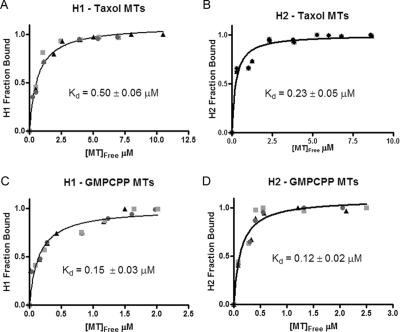Figure 3.
CLIP-170 can distinguish between GTP- and GDP-like microtubules. Cosedimentation assays were used to analyze CLIP-170 binding to microtubules. Microtubules stabilized with Taxol were used to mimic the GDP lattice of the microtubule. Microtubules stabilized with the slowly hydrolyzed GTP analog GMPCPP were used to mimic the GTP tubulin in the cap. The binding of 2 μM CLIP-170 fragments was measured as a function of microtubule concentration. Three separate experiments were performed and are indicated by squares, triangles, and circles. The fraction of CLIP-170 bound (in the pellet) was plotted against the concentration of unbound polymerized tubulin, and the three experiments then simultaneously fit to the bimolecular binding curve to obtain the apparent Kd (see Materials and Methods for details). Both H1 and H2 bind GDP microtubules with a strong affinity, 0.5 ± 0.1 μM (A) and 0.2 ± 0.1 μM (B), respectively. However, each construct binds the GTP-like GMPCPP microtubules more tightly, with respective Kd values of 0.15 ± 0.3 μM (C) and 0.12 ± 0.02 μM (D).

